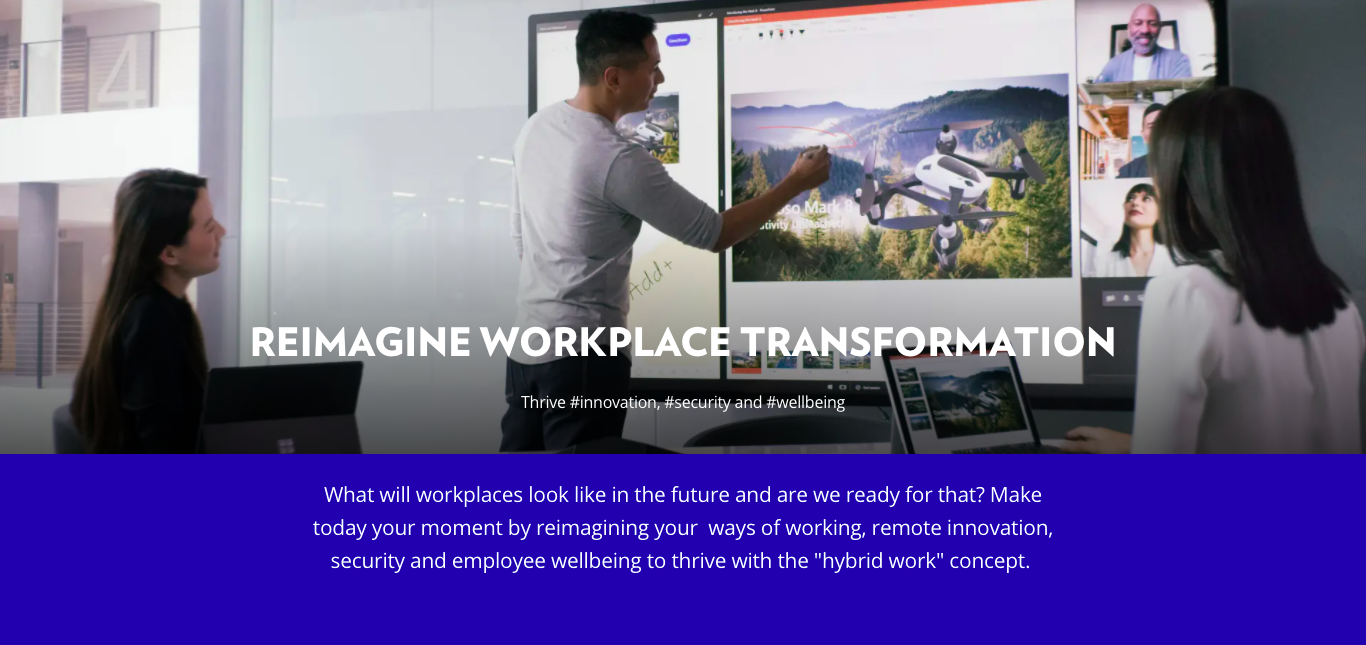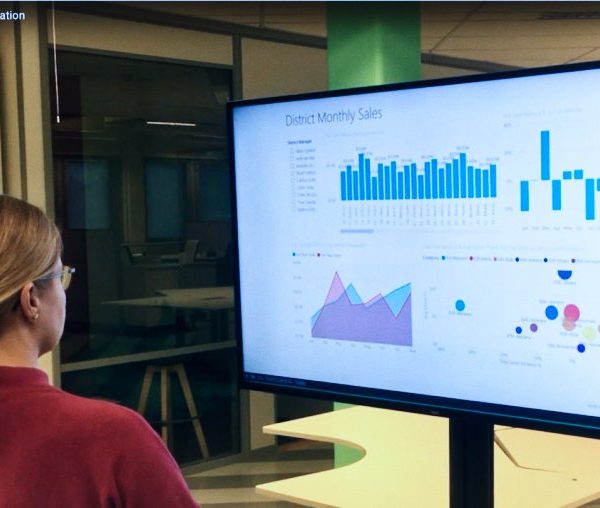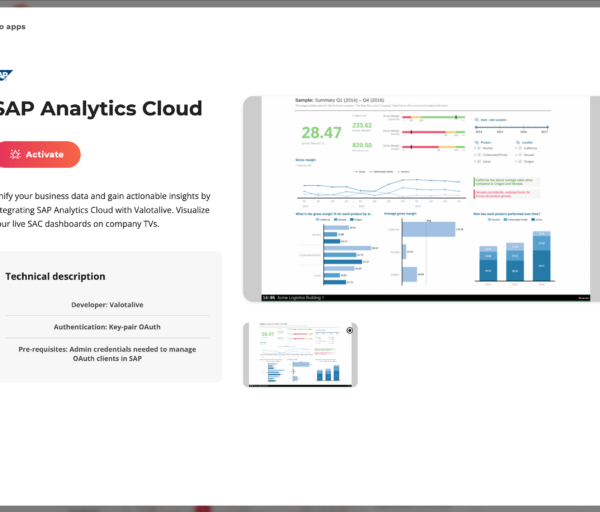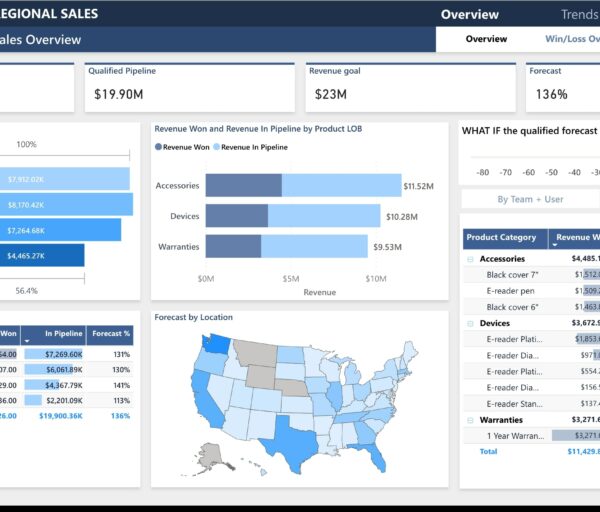Elisa Videra, powered by Microsoft, Valotalive and Poly, held the Reimagine Workplace Transformation online event on the 27th of May 2021. The event focused on the question “What will workplaces look like in the future and are we ready for that?”
If you were not able to participate or would like to recap on some of the key findings, you are at the right place.
In this article we cover four topics, and the key findings of each one, that were presented at the Event. These are:
- Leadership in the post-Covid world
- Design your work process to support remote innovation
- Unified Collaboration Experience in the “hybrid work”
- The future of new ways of working in the future workplaces
🎥 You can also find a link to access the video of the event at the end of this article.
So, Let’s go! 👇🏻
Leadership in the post-Covid world
Pasi Mäenpää, CEO of Elisa Videra
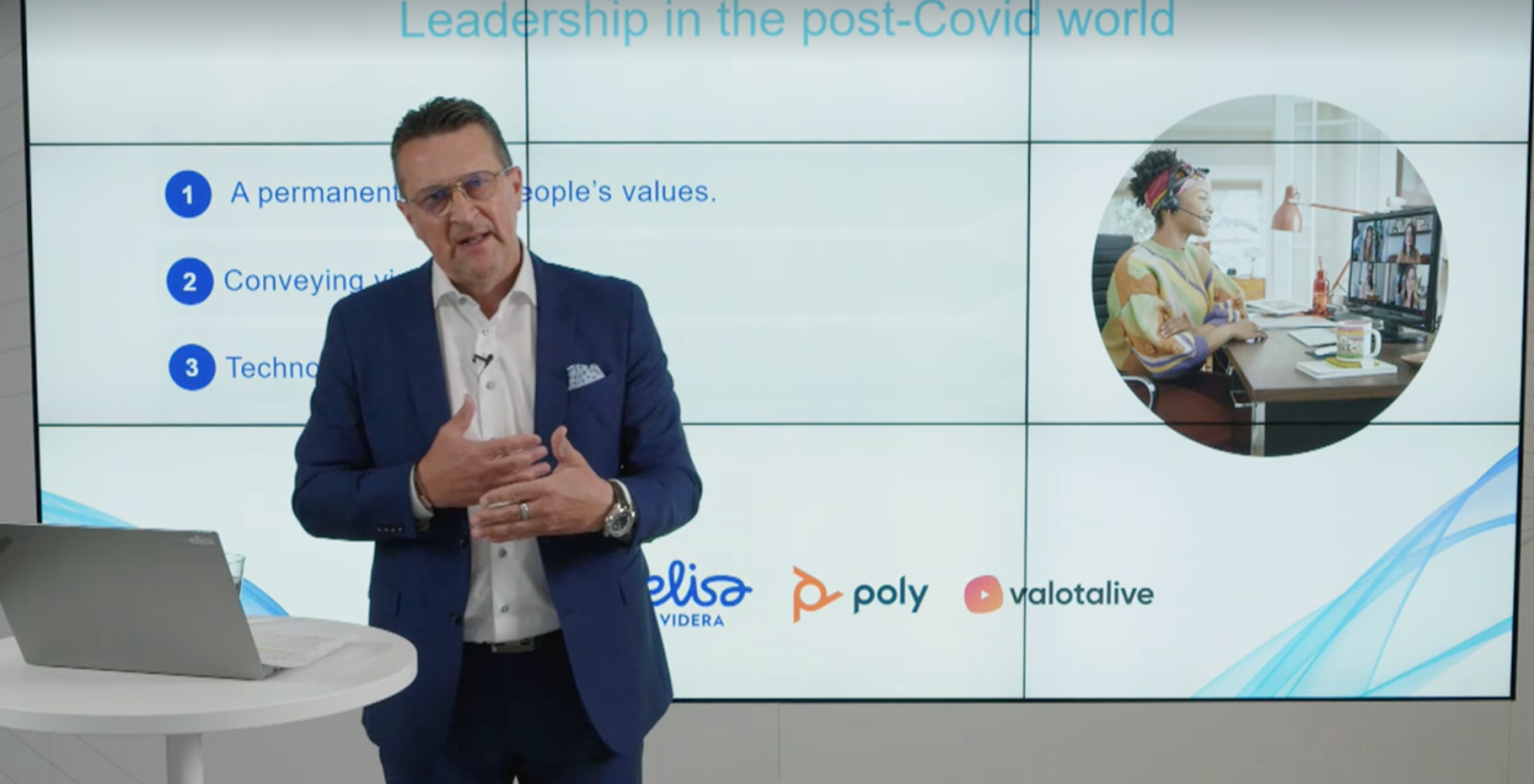
Permanent Change in people’s values
CEO of Elisa Videra Pasi Mäenpää notes that due to the pandemic, there has been, and still is, uncertainty that has had an effect on people’s values. People value wellbeing and family time more than before. The same applies to flexibility, according to studies up to 70% of the employees demand flexibility (regarding work arrangements).
Conveying virtual trust
There’s increasing demand for sustainable products and services. The same applies to sustainability regarding work. One of the questions is how often do we want or have to travel for business. There is a big change happening.
For leaders, this also brings challenges: how to virtually walk the talk? More than 90% of the communication is non-verbal. We are looking for people talking to people and having an interaction there.
Technologies are not rainmakers
We have had the tools (for remote work, virtual meetings…) for a long period of time, but have not used them effectively. Due to the pandemic this has now become a culturally accepted way of working and participating in the meetings.
There are also challenges, we need to figure out how to collaborate and work with external parties. How do we make sure that big sales can be made using just virtual tools?
The traditional offices as we used to know them, are dead. Now, there will be a new requirement set for the office, for meeting rooms, the amount of video (conferencing) equipment and more. Many will still carry on working from remote offices for 2-3 days a week.
Mikko Pulkkinen, COO Microsoft Finland
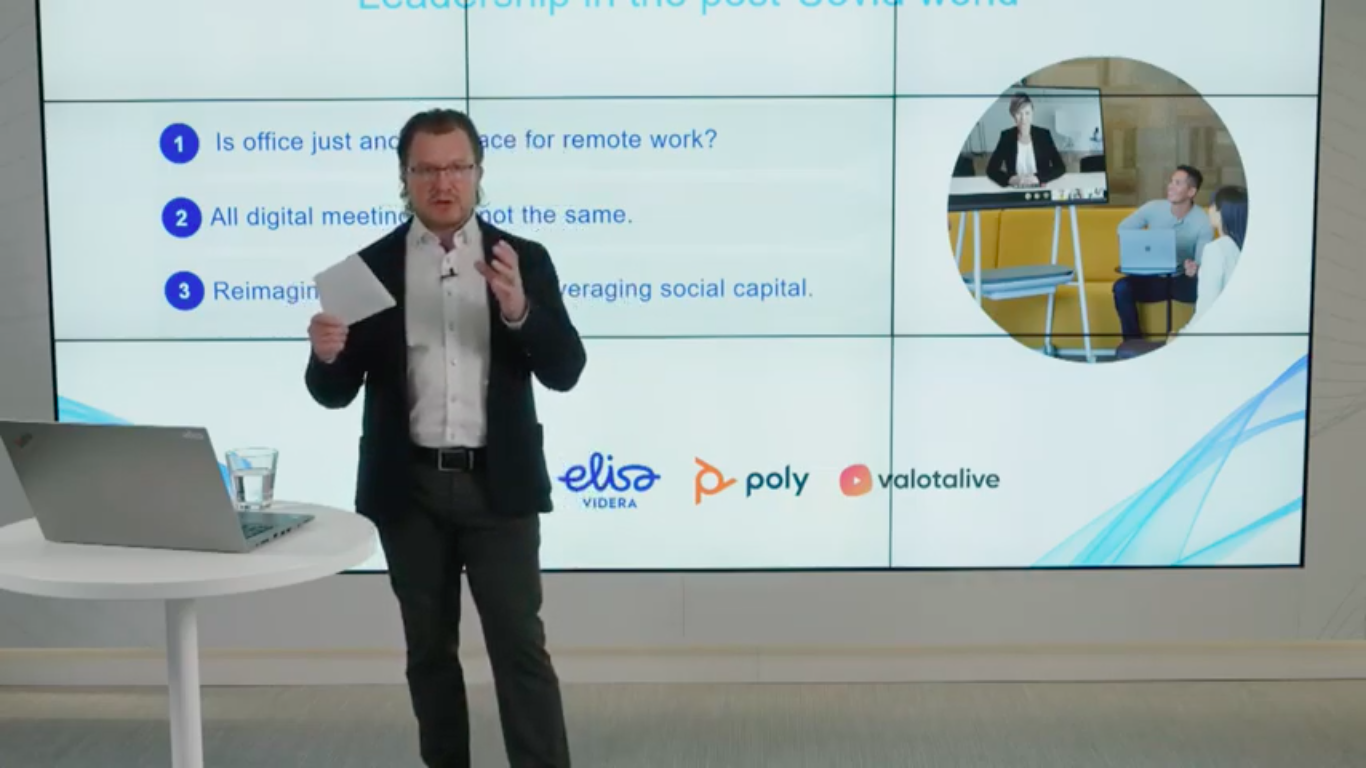
So much more can be done
COO Microsoft Finland, Mikko Pulkkinen shared his view how the pandemic has affected the way of working. The pandemic has taught us that so much more can be done remotely. We can say that flexible work is here to stay.
Use the momentum
We need to ensure that we use the momentum when people are coming back to the office, with the high expectations of meeting the colleagues again. This will be a different experience to what we have been used to in the past year.
Hybrid work is inevitable
We can say hybrid work is inevitable. We need to create a culture to enable it. Some of us we’ll be back at the office, some of us will stay remote and that will change the employee experience again. Technology has taken the role of the place, so culture requires more attention.
Rethinking the Employee Experience in the future workplaces
The pandemic has reinforced what we already know, work is so much more than getting things done. We need to empower employees to succeed and that requires rethinking the employee experience:
- Digitize every space & place to support hybrid work
- Make office spaces modular, combine with technology to ensure flexibility
- The place need to meet the evolving needs of employees
- Hybrid means full presence in meetings and in workplace
- Think about the purpose of the meeting (setup, management…)
Mikko Pulkkinen closed off with the note that we need to set a clear hybrid work policy that gives people a choice how, when and where they will work.
Design your work progress to support remote innovation
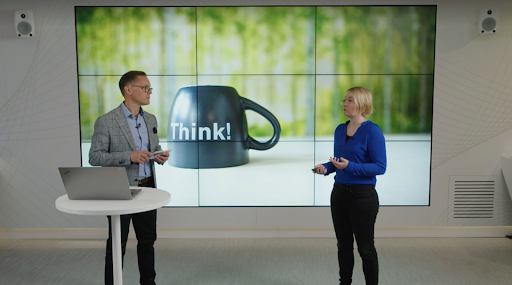
Tua Björklund from Aalto University and Aalto Design Factory has researched what innovating in this hybrid or remote time means. What can we do to make it work? 💡
The license to hustle
The pandemic has had an impact on us. Things that used to work before pandemic, no longer apply during the remote mode. If we think of innovation, a lot of things that do not work now give us room to try different things. The pandemic can be a kind of “license to hustle.” It can be easier to join people to change efforts.
Innovation
When we talk about innovation, we talk about change and we talk about people behind that change. The difference between a creative idea and innovation is whether that creative idea has been implemented. We are trying to change how people behave, whenever we are innovating. Look at the human element.
Two kinds of people
When we talk about innovation there are always two kinds of people. The people who are required to make the change (design, development, sales teams…) and the people who are affected by the change (customers and those whose processes are affected by new ideas)
Take both groups into consideration.
Customers
80% of the companies report providing a superior customer experience, but only 8% of their customers agree (Bain & Co study).
While we have increased our communication by using collaboration tools, external communication is way down (Microsoft study). People are having less contact with people outside their organisation. This is the key problem when we think about the pipeline of innovation.
Try these:
- Think about how can we add a bit more contact with our customers – eve short 15 minute conversation can help
- Tag along with the people, as an observer, in the organisation that are already on the frontline – join sales calls, R&D groups, services teams, visit shops
- Interview (informal) the people who are interacting with the customers – 15 minutes check up by the coffee machine, hallways…
→ Get more raw material and insights to understand the problems we are trying to solve and the value we are bringing to the customer.
Bring room for participation – leverage the diverse perspectives
We think of innovation and creativity as out of the box solutions. The easiest way to get out of the box is to describe that box differently. What we think that issue is, will influence how we try to solve the problem.
The more sets of eyes we have on the problem, the more likely it is that we find a different angle and bring an opportunity to bring additional value.
So, mindful practices to make participation easier. According to MS study younger people and those in minority are struggling to pitch their ideas while working in the remote environment. How can we reach these people?
- Make room in meeting agenda for feedback
- Ask for comments
- Ask a colleague in the different departments
→ Having a specific question in mind can help with input.
→ Encourage people to come up with problems, even if they do not have ready solutions in mind.
Counteract the “…uummm, yea, but…” mentality with “Yes, and” mindset. They key here is to keep those requests small enough, ask for comments throughout the process.
Innovation process
Tua introduced the double diamond pipeline. Also, good to note that a lot of innovation happens already before we enter the pipeline.
The left hand side – Looking at the initial problem. How can we identify the right issue to solve? We need to find ways of experimentation, prototyping to learn and arrive at a problem we are solving.
Make it visible
Make your ideas, stories visible. Use storyboards to represent initial thinking online. Research shows that progress is the number one thing that predicts whether we have the energy to develop something tomorrow as well as today.
Think about the smallest step that we can do to move our ideas forward. So you can see some progress, something that you can demonstrate to other stakeholders around you. Get that idea out there, so others can comment on it and others can build on it.
→ Keep good intentions alive, think about the least you can do.
Unified Collaboration Experience in the “hybrid” work
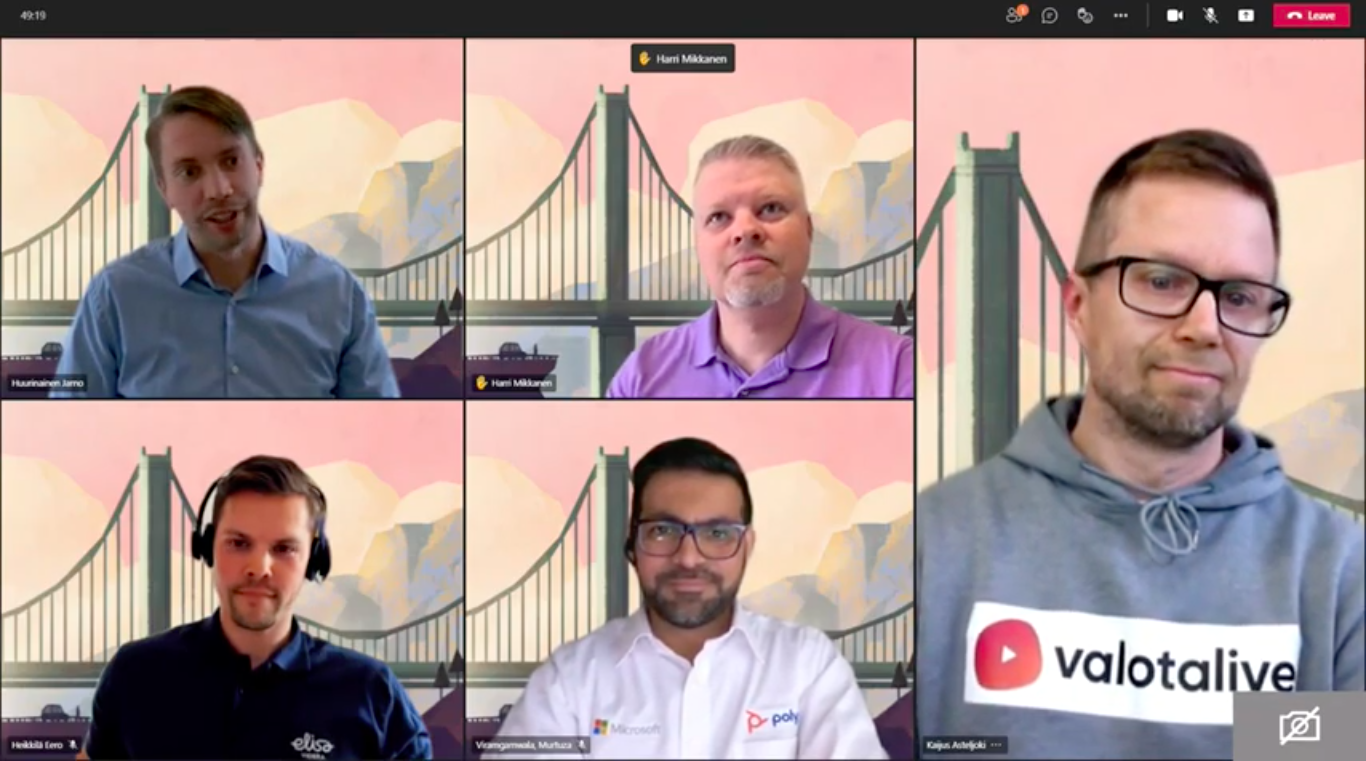
This was a panel discussion led by Jarno Huurinainen, the panelists were Murtuza Viramgamwala from Poly, Harri Mikkanen from Microsoft, Kaijus Asteljoki from Valotalive and Eero Heikkilä from Elisa Videra.
Experiences with the unified collaboration solutions in the ‘hybrid work’ environment
A Step forward in terms of Personal Know-how
Harri from Microsoft commented that the pandemic has encouraged us to take a step forward in terms of technical knowledge regarding virtual meetings. Those who have had less experience have more know-how now and we can have our voices heard equally. It used to be so that some handled the tools better than others and had the “advantage”.
A Step forward in terms of Personal Devices
Murtuza, from Poly, pointed out that when the pandemic struck it was an eye opener for the company how much there was demand for the personal devices as the remote-home offices were “built”.
Encouraging for “Keeping Video On” culture
Kaijus gave an example of how Team Valotalive has had virtual team lunches to address the lack of social life during the pandemic and remote work. Keeping the video on, in virtual meetings like these, has helped to feel the connection between people and the team to be more engaged.
The demand for cross platform interoperability increased
Eero, from Elisa Videra, described how, with the increase in the amount of virtual meetings, the demand for cross platform interoperability between the tools has also increased. Something that Elisa Videra can help with.
Eero also highlighted the challenges to make remote workers feel as engaged when we were all at the office.
What are the phases or issues that business may go through when making these adaptations and how can technology partners help?
Take all employees into account from Remote offices to those fully onsite at the production facilities
Kaijus pointed out that while many of us have been in the agile, hybrid or full remote mode of working, the majority of the world’s workforce do not have desks. In many cases hybrid work is not possible for those groups.
This has forced companies to develop their solutions, in parallel, to enable both agile remote work and safe environments for the onsite teams. Making sure they are kept up to date and engaged as well.
Rexel, as an example, is using corporate signage integrated with Power BI to display live KPIs of operational data. These big screens throughout the distribution facilities especially help employees who might not have laptops or mobile devices at hand to stay informed.
At the same time they are using these screens to communicate with safety information and company announcements making sure employees are following the right procedures to keep the facility safe even during the pandemic.
We need to help customers find solutions for remote workers, office workers in hybrid mode and non-desk workers that are fully on-site. Elisa Videra as a service provider is in a perfect position to offer solutions for each of these scenarios.
The platform to be heard and seen equally
Murtuza described that when we are returning to the offices, there are still some people that will continue to work remotely. We need to make sure that everyone in all situations will be heard and seen equally. We can do that by thinking, not only about the equipment at the office, but how to make sure that the people at the remote offices have the same tools and capabilities to provide the equal participant experience.
Working together
Harri raised the questions of how do we rethink the way to work together when we are in the hybrid mode and in between the meetings. It’s easier when we are all either onsite or virtually remote, but the hybrid brings a bit of a challenge.
What is the future for unified collaboration and new ways of working?
Onsite User Experience supporting Innovation
Kaijus believes businesses are waiting for the employees to return to the offices, at least partially for the hybrid mode. It is a known fact that much of the innovative collaboration and innovation rely on the physical presence of employees.
He highlighted the role and functions of the office. The onsite facilities will be changing. These spaces need to deliver even better overall user experience for the employees. The digital side of the business will blend into the physical space to keep employees engaged and to make sure we reach all employees.
We will see the office and onsites spaces integrated with collaboration tools and business applications to deliver even better user experience for the increasing needs of employees and different employee groups.
People value flexibility and the opportunity to work remotely
Eero noted that remote work is here to stay. This flexibility is something that future employees will expect from their employers. They will not even consider the job without the option.
Automation will keep accelerating
Harri explained how we often create content that we do not even categorise information. However the best companies will use technology to transform this data to knowledge or even intelligence. Harri thinks that the key here is for us to trust more in technology. That we would get intelligent proposals for the best next actions for us.
The video
🎥 You can watch the recap of the event in the Reimagine Workplace Transformation following this link. Registering Required. The link to the video will be provided by Elisa Videra: https://response.questback.com/elisa/sul8hrqdts.
